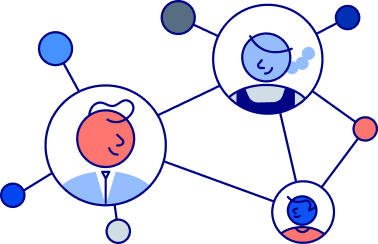This blog post was co-authored by Aaron Blumberg, Partner & Attorney at Fragomen.
The H-1B is the most popular employer-sponsored visa option for graduating international students. However, it is not the easiest option for everyone. International students who are not successful in the H-1B lottery or don’t have an employer to sponsor them, such as entrepreneurs, may seek out alternatives to the H-1B visa.
What Is an H-1B Visa?
The H-1B is one of the most common employer-sponsored visas in the U.S. Every year, hundreds of thousands of applicants enter a lottery to apply for it. Unfortunately, there are only 65,000 H-1B visas available per year for graduates with a bachelor’s degree. If you have a master’s or other advanced degree from a U.S. university, you are eligible for an additional 20,000 visas in the lottery. A lottery is held each March to determine who is allotted one of the 85,000 H-1B visas.
One of the benefits of the H-1B is that it is a dual intent visa, which means you can apply for permanent residency while on this visa. The H-1B visa lasts up to six years with the possibility for further extensions in limited circumstances.
H-1B Cap Exemptions
The following types of U.S. employers are exempt from the H-1B lottery and associated quota:
- Public and private non-profit colleges and universities
- Non-profit research organizations
- Government research organizations
- Non-Profit entities affiliated with a qualifying college/university
Instead of applying for an H-1B visa by entering the lottery, the employer submits a petition to USCIS directly and the case is reviewed on its merit. This increases your likelihood of being granted an H-1B visa. You can apply any time of year rather than waiting until March for the lottery.
Interstride’s student portal lets you search specifically for H-1B cap-exempt jobs. Talk to your university about partnering with Interstride for access.
What Are the Alternatives to H-1B
With the high demand for H-1B and a difficult lottery system, it’s easy to see why international students and recent graduates are looking for H-1B alternatives. If you are not able to find a cap-exempt job, there are other H-1B alternatives, whether you are seeking a temporary visa or permanent residence in the U.S.
Work Authorization for Student Visas
For international students on an F-1 visa, the Optional Practical Training (OPT) program allows you to work in the U.S. for up to one year after graduation or for up to three years for certain STEM majors.
Here are some key things to know about OPT:
- The job must be relevant to your field of study.
- You can use OPT before and after graduation but only for the total time allowed.
- If you re-enroll in school as a graduate student (after completing your bachelor’s), your allotted OPT time restarts. You can have 1 period of authorized OPT per subsequent academic level (ie OPT for Associates degree and then again for Bachelor’s and then Masters, etc.)
- OPT and STEM OPT have a 60-day grace period before you must leave the country.
International students studying STEM on a J-1 visa have a work authorization option through the Academic Training (AT) program. AT typically only lasts 18 months, but the Biden administration has expanded the program to offer a total of 36 months of work authorization for undergraduate and graduate students in STEM fields (as long as the AT does not exceed the length of the degree program). Like OPT, AT jobs must be directly related to the student’s field of study. The grace period after AT ends is 30 days.
Temporary Work Visas for Foreign Nationals From Specific Countries
There are three different work visas for foreign nationals from specific countries. These visas have varying requirements, but they are all temporary visas that do not allow for dual intent. That means it can be challenging to apply for a green card on any of these visas.
- E-3 for Australian citizens
- H-1B1 for Chilean and Singaporean citizens
- TN for Mexican and Canadian citizens
There are 10,500 E-3 visas for Australian citizens available per year. They require employer sponsorship in a specialty occupation which requires at least a bachelor’s degree. A specialty occupation is defined as any occupation that applies highly specialized knowledge, so STEM jobs normally qualify. An E-3 visa lasts two years with indefinite extensions possible.
The H-1B1 visa for Chilean and Singaporean has the same requirements as the E-3 visa. However, it only lasts one year before renewal is needed. There are only 1,400 H-1B1 visas for Chilean citizens and 5,400 for Singaporean citizens each year.
The TN visa for Mexican and Canadian citizens requires employer sponsorship, and only specific occupations qualify for this visa. There is no limit on the number of TN visas offered each year. The visa lasts three years with the option to renew indefinitely. Canadians may apply for a TN Visa at the border while Mexicans must apply at a consulate abroad.
L-1 Intracompany Transfer
The L-1 visa is for intracompany transferees. To qualify, you must work for one year in another country as an executive, manager or someone who possesses specialized knowledge. Then, you can transfer from that country to the U.S. with an affiliated company such as a parent company, subsidiary, or branch. STEM graduates who are considering this option should look for employment at companies that have locations in the U.S. and in other countries that have less strict immigration laws (or your home country).
There are two types of L-1 visas. L-1A is for executives and managers. This visa can last up to seven years, but recent graduates may not qualify for these positions due to a lack of managerial experience. The L-1B is typically a better option for international students who recently graduated because it is for workers with specialized knowledge at their job. This visa can last up to five years with extensions.
Both L-1A and L-1B are dual intent visas, so you can begin the process of applying for permanent residency while working in the U.S. on an L-1 visa. Another benefit of L-1 visas is that the spouses of visa holders are also authorized to work in the U.S.
O-1 for Persons With Extraordinary Ability
The O-1 employer-sponsored visa may be a good option for STEM graduates with extraordinary ability in one of the following areas:
- Science
- Arts
- Education
- Business
- Athletics
To qualify, applicants must demonstrate exceptional ability by providing evidence for at least three out of eight criteria. It is never too early to start working on meeting these criteria even if you are still in college. The O-1 visa is appealing for many recent graduates because it can be extended an unlimited number of times, and you can apply for permanent residency while on an O-1.
Self-Sponsored Permanent Residency Options
For STEM graduates seeking permanent residency, it is possible to apply for a green card without H-1B status. If you are an international student on an F-1 visa, you can actually begin applying for your green card before you graduate, but it can be complicated and usually is recommended to work with an attorney. There are two types of green cards that are relevant to STEM professionals and do not require employer sponsorship: EB-2 National Interest Waiver (NIW) and EB-1A Extraordinary Ability.
EB-2 NIW
The EB-2 NIW is for those whose impact will benefit the U.S. Because you can self-sponsor, this is a good option for STEM entrepreneurs as well as for researchers/scientists. The work you plan to do must have substantial merit and national importance, and you must prove that you are well-qualified for the role. Additionally, there must be an urgency to the work to waive the labor certification steps usually required for green cards.
EB-1A
To qualify for an EB-1A green card, an applicant has to show that they are in the top of their field and must meet three out of ten criteria. If you are thinking about an EB-1A green card, start preparing while you are still in school to work towards being at the top of a niche field.
Processing times for EB-1A are often shorter than the processing times for the EB-2 NIW. International STEM students from China and India may be especially interested in the EB-1A option because it has significantly shorter wait times than most other green card categories.
How Can an Immigration Services Agency Work for You?
If you missed the deadline for the H-1B lottery or didn’t get selected, you have other options. Consider using OPT or Academic Training if you are a graduating international student with F-1 or J-1 status and have not yet taken advantage of these work opportunities. For STEM graduates whose goal is permanent residency, consider a visa such as an O-1 or L-1.
Still not sure what visas you qualify for and how to apply for them? Fragomen can help you find the best H-1B alternative for your specific situation. With 70 years of experience in immigration services, Fragomen brings a wealth of knowledge to ensure that your immigration journey is as seamless as possible. Get in touch today to see how our immigration professionals can support you.
























